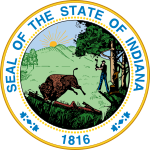
Frank Lewis O'Bannon was an American politician who served as the 47th governor of Indiana from 1997 until his death in 2003. He is the most recent U.S. Governor to have died in office.

Joseph Eugene Kernan III was an American businessman and Democratic politician who served as the 48th governor of Indiana from 2003 to 2005. He previously served as the 47th lieutenant governor of Indiana from 1997 to 2003 under Frank O'Bannon and succeeded the governorship after O'Bannon's death. Kernan had also served nearly a year as a prisoner of war during the Vietnam War.

David Martin McIntosh is an American attorney and Republican Party politician who served as the U.S. representative for Indiana's 2nd congressional district from 1995 to 2001. He is a co-founder of two conservative political groups, The Federalist Society and The Club for Growth.

The 2006 Texas gubernatorial election was held on November 7, 2006, to elect the governor of Texas. The election was a rare five-way race, with incumbent Republican Governor Rick Perry running for re-election against Democrat Chris Bell and Independents Carole Keeton Strayhorn and Kinky Friedman, as well as Libertarian nominee James Werner.
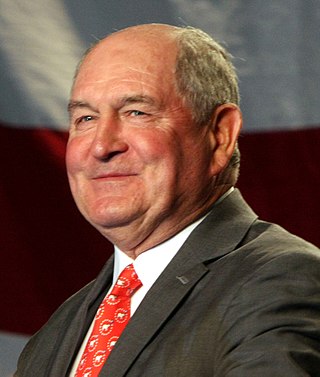
The 2006 Georgia gubernatorial election was held on November 7, 2006. Georgia incumbent Republican Governor Sonny Perdue ran for re-election to a second and final term as governor. Governor Perdue was renominated by the Republican Party, defeating a minor opponent in the process, while Lieutenant Governor Mark Taylor narrowly emerged victorious from a competitive Democratic primary. In the general election, though Taylor ran a spirited campaign, Perdue was aided by the increasing tendency of the state to vote for Republicans and by his popularity with the public; polling showed his approval ratings above sixty percent. In the end, Perdue was overwhelmingly re-elected as governor, defeating Taylor in a landslide, becoming the first Republican Governor of Georgia to ever be reelected. As of 2022, this is the last time that Muscogee, Warren, Rockdale, Chatham, and Bibb counties voted for the Republican candidate for governor and the last time that Marion, Telfair, and Wheeler counties voted for the Democratic candidate.

United States gubernatorial elections were held on November 7, 2000, in 11 states and two territories. The elections coincided with the presidential election. Democrats gained one seat by defeating an incumbent in West Virginia. As of 2024, this remains the last gubernatorial cycle in which a Democrat won in Indiana.

The 2008 Indiana gubernatorial election was held on November 4, 2008. Incumbent Republican nominee Mitch Daniels was challenged by Democratic nominee Jill Long Thompson and Libertarian nominee Andy Horning. Daniels easily won reelection, defeating Long Thompson by over 17 points. Despite Daniels' landslide victory, Barack Obama narrowly carried Indiana in the concurrent presidential election; the only Democratic candidate to do so since 1964.
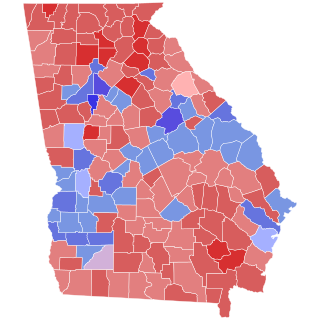
The 2008 United States Senate election in Georgia took place on November 4, 2008. The run off election took place on December 2, 2008. Republican Senator Saxby Chambliss, first elected in 2002, sought re-election to his position as a United States Senator from Georgia. He was challenged by Democratic nominee Jim Martin and Libertarian nominee Allen Buckley. After a runoff election on December 2, Chambliss was elected.

The 2010 Georgia gubernatorial election was held on November 2, 2010. Incumbent Republican Governor Sonny Perdue was term-limited and unable to seek re-election. Primary elections for the Republican and Democratic parties took place on July 20. Democrats nominated former Governor Roy Barnes, and Republicans nominated Representative Nathan Deal following a runoff on August 10. The Libertarian Party also had ballot access and nominated John Monds. Deal won the general election, and took office on January 10, 2011.

The 2004 Indiana gubernatorial election took place on November 2, 2004, to elect the Governor of Indiana.
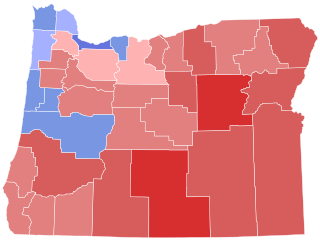
The 2002 Oregon gubernatorial election took place on November 5, 2002. Incumbent Democrat John Kitzhaber was barred by term limits from seeking a third consecutive term; he later successfully ran again in 2010 and 2014. To replace him, former Oregon Supreme Court Associate Justice Ted Kulongoski won a crowded and competitive Democratic primary, while former State Representative Kevin Mannix emerged from an equally competitive Republican primary. The campaign between Kulongoski and Mannix, who were joined by Libertarian nominee Tom Cox, was close and went down to the wire. Ultimately, Kulongoski eked out a narrow margin of victory over Mannix, which was slightly smaller than Cox's total vote share, allowing Kulongoski to win what would be the first of two terms as governor. As of 2023, this is the last time that Oregon voted for a gubernatorial nominee and a U.S. Senate nominee of different political parties.

The 2010 Illinois gubernatorial election took place on November 2, 2010. Incumbent Democratic Governor Pat Quinn was elected to a full term in office, having become governor in 2009 following the impeachment and removal of Governor Rod Blagojevich. Quinn was elected as the Democratic nominee, the Illinois Green Party nominee was attorney and 2006 nominee Rich Whitney, the Republican nominee was State Senator Bill Brady, the Libertarian Party nominee was Lex Green, and Scott Lee Cohen ran as an independent.

The 1997 New Jersey gubernatorial election was held on November 4, 1997. In the Democratic primary, state senator and Woodbridge Township mayor James McGreevey defeated pre-U.S. Rep. Rob Andrews by 9,993 votes. In the general election, Republican Governor Christine Todd Whitman defeated McGreevey by 26,953 votes. Whitman won 46.87% of the vote, with Democratic nominee James McGreevey receiving 45.82% and Libertarian Murray Sabrin receiving 4.7%.

Elections were held in Indiana on Tuesday, November 2, 2010. Primary elections were held on May 4, 2010.

The 2012 Indiana gubernatorial election took place on November 6, 2012. Incumbent governor Mitch Daniels was term-limited and unable to seek a third term. The Republican candidate, Congressman Mike Pence; the Democratic candidate, former Speaker of the Indiana House of Representatives John R. Gregg; and the Libertarian candidate, youth mentor, small business owner and reality TV personality, Rupert Boneham, were all unopposed in their respective primaries or conventions and contested the general election. This is the first open Indiana gubernatorial election since 1996 and the first gubernatorial election since 1972 without the governor or lieutenant governor as a nominee.
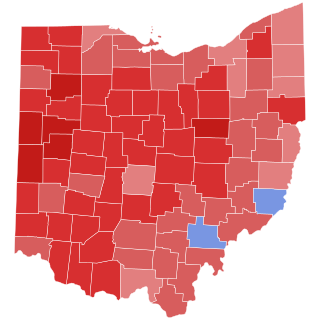
The 2014 Ohio gubernatorial election took place on November 4, 2014. Incumbent Republican Governor John Kasich won reelection to a second term in office by a landslide over Democratic candidate Ed FitzGerald and Green Party candidate Anita Rios. Primary elections were held on May 6, 2014.

The 1996 Indiana gubernatorial Election was held on November 5, 1996, alongside the election of both houses of the Indiana General Assembly. Incumbent Governor Evan Bayh, a Democrat, was ineligible to run for a third consecutive term due to term limits established by the Indiana Constitution. He was succeeded by Lt. Governor Frank O'Bannon, who won election over Republican Stephen Goldsmith with 52% of the vote.

The 1988 Indiana gubernatorial election was held on November 8, 1988, in all 92 counties in the state of Indiana. Incumbent Governor Robert D. Orr, a Republican, was ineligible to run for a third consecutive term due to term limits establish by the Indiana Constitution. In the general election, the Republican nominee, Lieutenant Governor John Mutz, was defeated by Democrat Indiana Secretary of State Evan Bayh by a margin of six percentage points. Bayh was the first Democrat to be elected Governor of Indiana since Roger D. Branigin's victory during the 1964 Democratic landslides twenty-four years previously.

The 2016 Indiana gubernatorial election was held on November 8, 2016, to elect the governor and lieutenant governor of Indiana, concurrently with the 2016 U.S. presidential election as well as elections to the United States Senate and elections to the United States House of Representatives and various state and local elections. The primaries were held on May 3, 2016. Republican lieutenant governor Eric Holcomb won the race with 51.4% of the vote.

The 2020 Indiana gubernatorial election was won by incumbent Republican Eric Holcomb on November 3, 2020. The election was held concurrently with the 2020 U.S. presidential election, as well as elections to the United States House of Representatives and various state and local elections.

